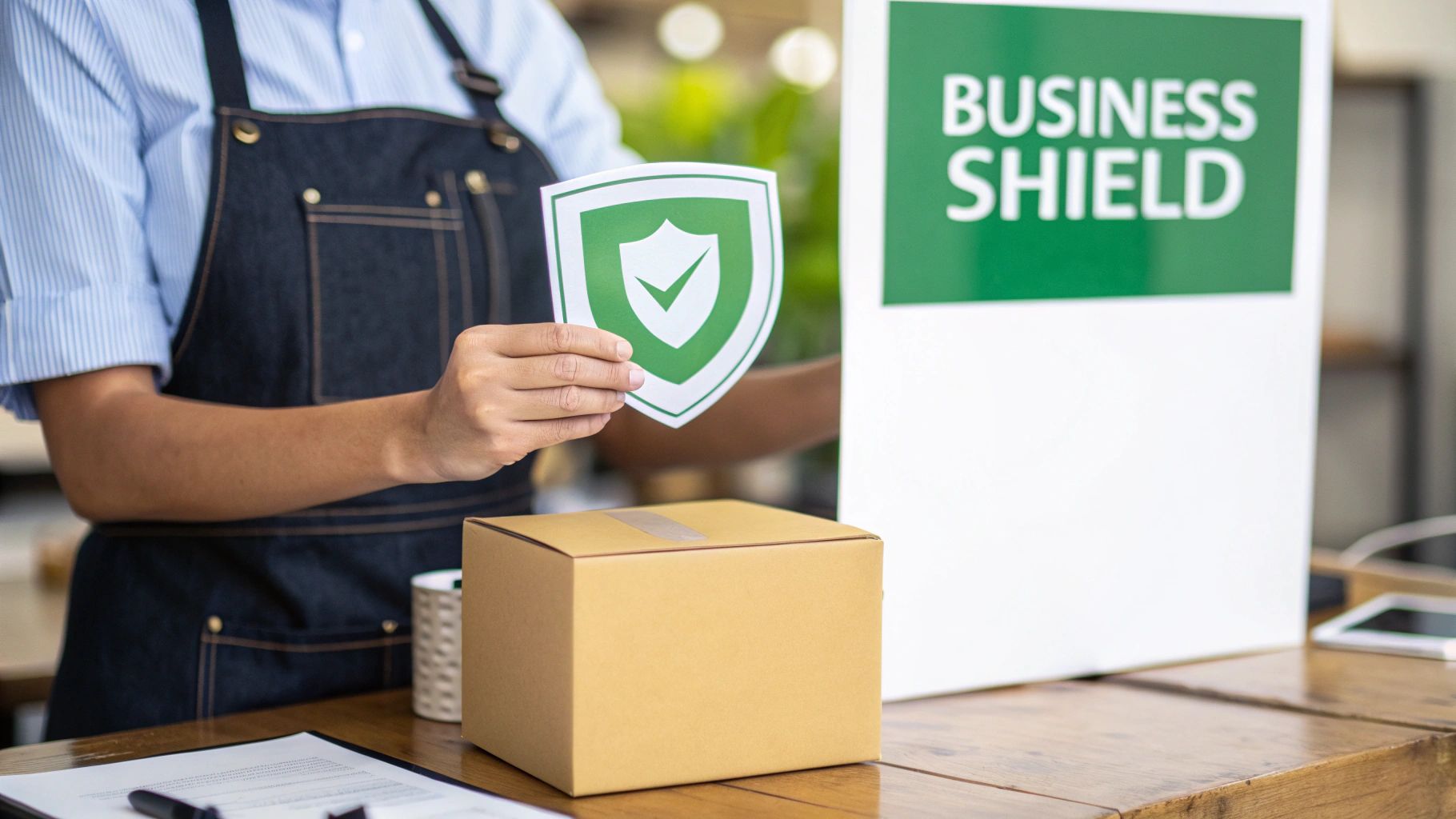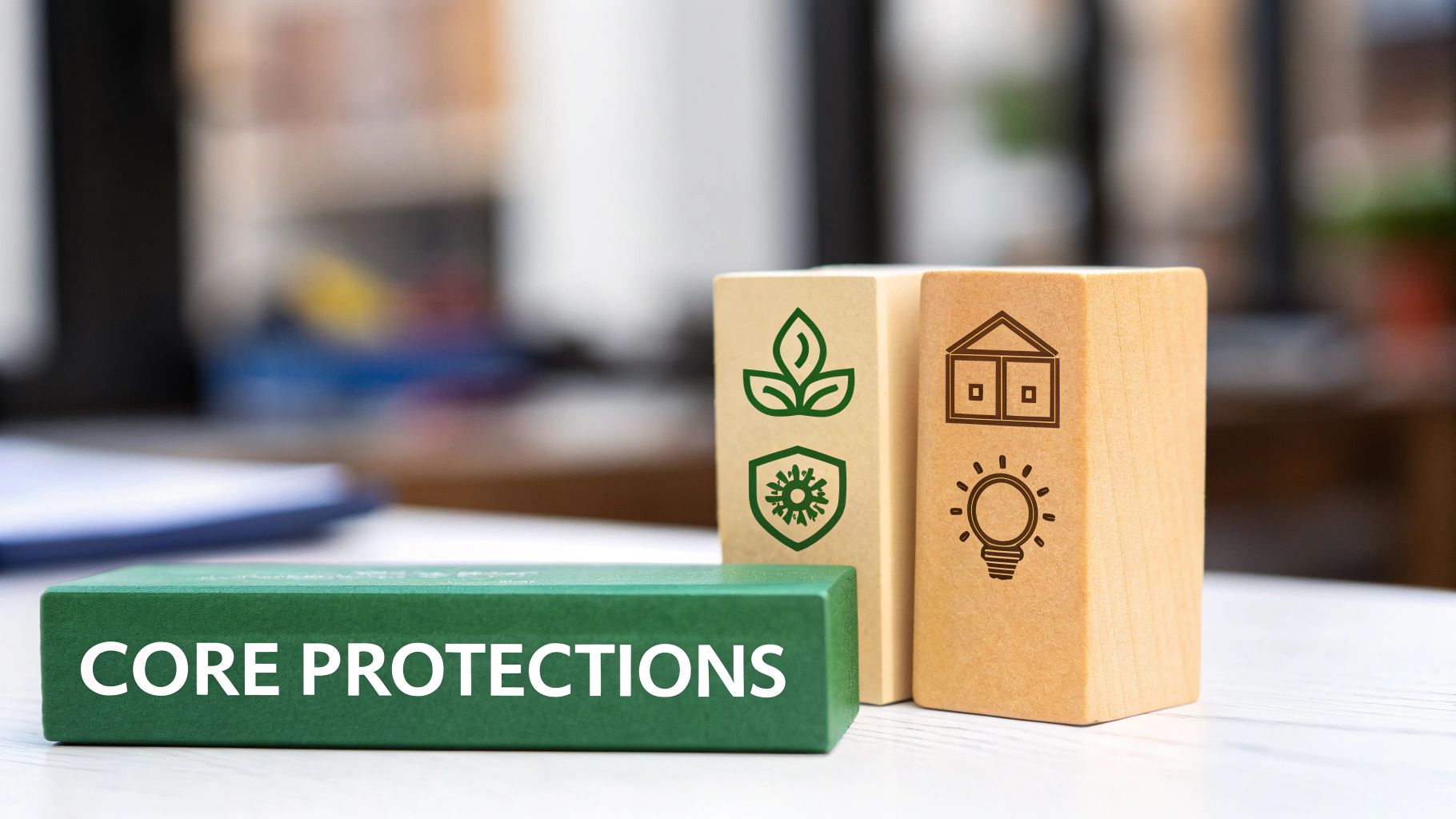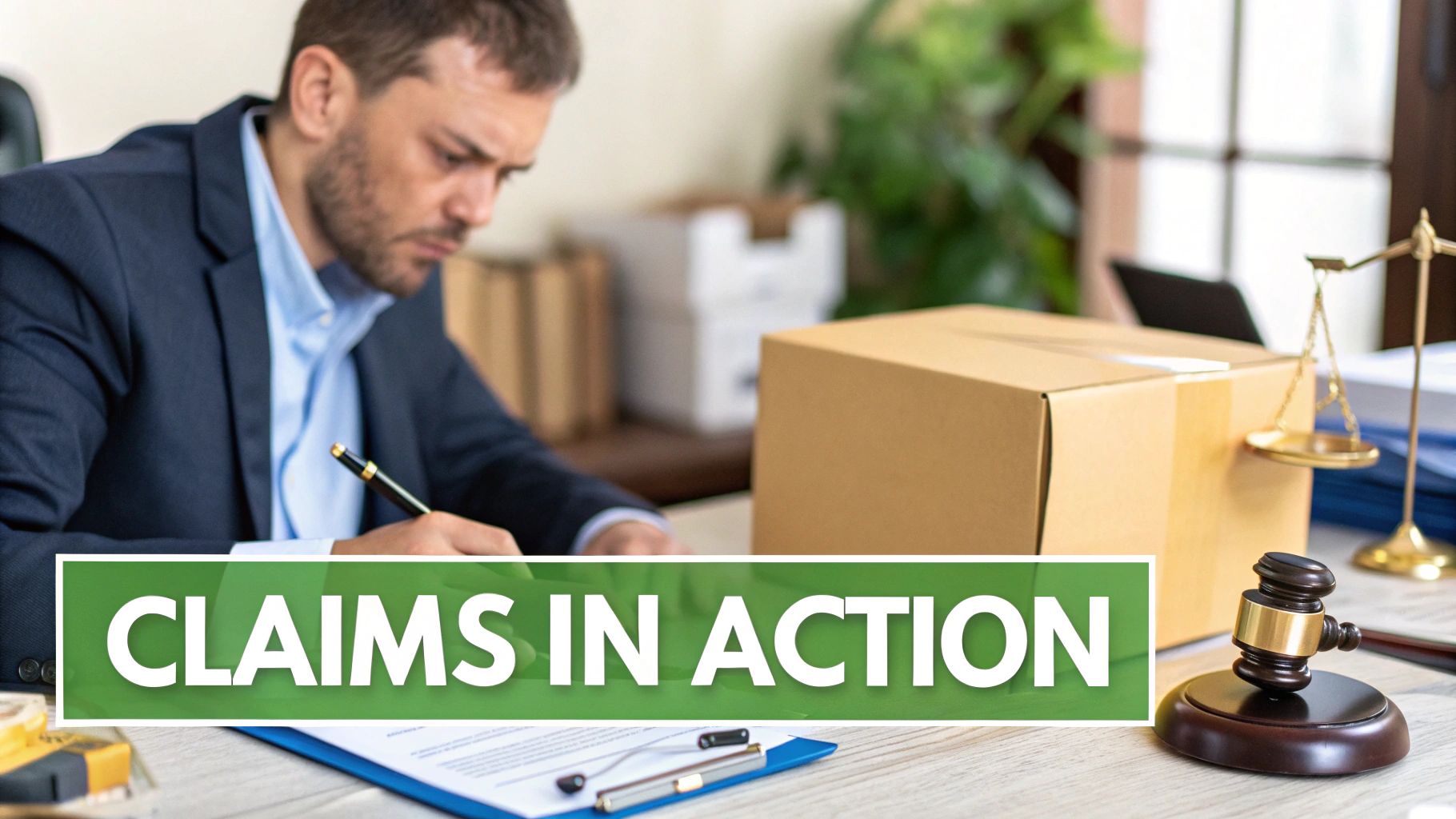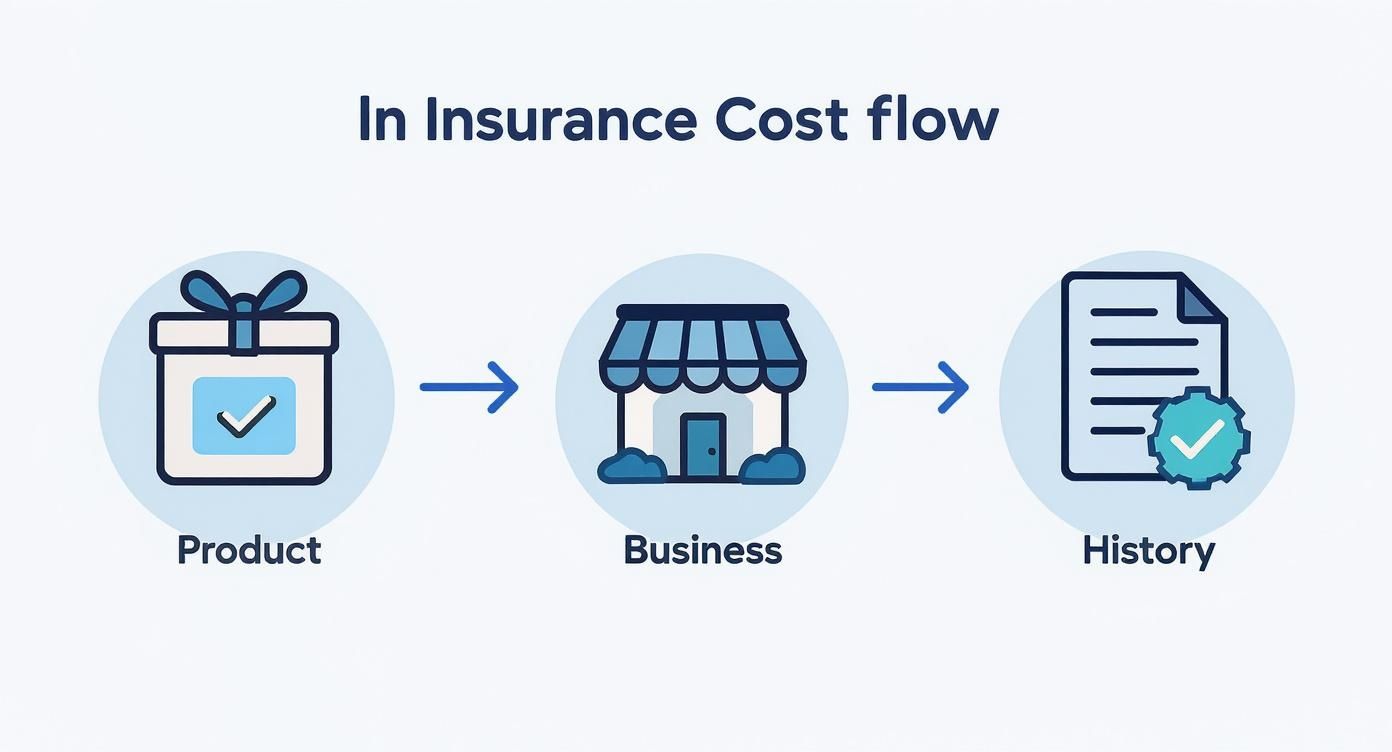If you make, sell, or even just handle a product on its way to a customer, you're carrying a certain amount of risk. Product liability insurance is your financial shield against claims that something you sold caused bodily injury or property damage.
It’s designed to step in and cover the often-crippling costs of legal defense, settlements, and court-ordered awards if a customer claims your product hurt them. Think of it as a crucial safety net for any business that puts a physical product into the world.
Getting to the Core of Product Liability
From the moment a product leaves your hands, you’re on the hook. It doesn't matter if you're a massive manufacturer, a regional distributor, or a solo entrepreneur selling handmade goods online—the risk is real.
A seemingly small problem, like a toy with a loose part or a cosmetic with an unlisted allergen, can snowball into a massive lawsuit.
Without this specific type of insurance, just one claim could put your entire business in jeopardy. Legal fees can pile up fast, even if you’re eventually found not at fault. This is why a dedicated policy is a cornerstone of smart risk management. It's just one of several different types of commercial insurance policies that form a complete protective strategy for your business.
Why It's More Than Just "Nice to Have"
The numbers tell a stark story about why this coverage is so vital. The global liability insurance market is on track to hit $309.5 billion by 2025. Even more sobering? The average product liability payout at trial hovers around $7 million.
It's no surprise that small and mid-sized manufacturers are big believers in this coverage, making up roughly 60% of all new policies. These aren't just abstract statistics; they represent real businesses facing potentially catastrophic legal challenges.
To put it simply, here’s a quick breakdown of what this insurance is all about.
Product Liability Insurance at a Glance
| Key Aspect | Simple Explanation |
|---|---|
| What It Is | A specialized insurance policy covering claims of injury or damage caused by your product. |
| Who It Protects | Manufacturers, distributors, retailers, wholesalers—anyone in the product's supply chain. |
| What It Covers | Legal defense costs, settlements, and court awards resulting from a product liability lawsuit. |
| Why It's Essential | A single claim, even a baseless one, can be financially devastating without this protection. |
This table helps illustrate that product liability insurance isn't just an expense; it's a fundamental investment in your company's future.
In essence, product liability insurance isn't just a line item on your budget; it's an investment in your business's survival and reputation. It gives you the peace of mind to innovate and sell, knowing you're prepared for the unexpected.
This coverage is built to absorb the financial shock of a claim, so you can stay focused on what you do best: running your business. It generally protects you from three primary types of claims:
- Design Defects: The problem is baked into the product’s original blueprint, making the entire line unsafe.
- Manufacturing Defects: An error or fluke happened during production, making a specific batch or unit dangerous.
- Marketing Defects: The issue lies in how the product was sold—think improper labeling, bad instructions, or a failure to warn of dangers.
Who Actually Needs This Insurance Coverage?
It’s a common misconception that product liability insurance is only for huge companies with massive factories. The truth is, if your business plays any part in a product's journey to the customer, you're on the hook. Liability isn't just about who made the product; it follows that product down every single step of the supply chain.
Think of it like a chain of dominoes. A faulty product can be the first domino to fall, but the financial and legal fallout can knock over every business in the line. To see if you're one of those dominoes, you have to understand exactly where you fit in.
The Original Creators: Manufacturers
This one is the most obvious. If you design, build, or assemble a product, you’re on the front lines of liability. You hold the primary responsibility for making sure what you create is safe.
Let's say a popular kitchen blender has a wiring flaw that creates a fire hazard. The manufacturer is almost always the first one pointed at for that kind of design or production mistake. This direct link to the product's creation means manufacturers carry the highest level of risk, from the initial blueprint to the raw materials they select.
The Middlemen: Wholesalers and Distributors
Just because you didn't invent or build the product doesn't mean you're safe. Wholesalers and distributors are crucial links in getting products to market, and that position comes with real risk—even if you never open the shipping crate.
Imagine you're a distributor supplying a new skincare cream to hundreds of spas. If that cream is later found to contain a banned ingredient that causes severe rashes, your distribution company can be named right alongside the manufacturer in a lawsuit. Why? Because you were a key player in bringing that harmful product to the public.
Simply put, passing a product from one point to another makes you a part of its story. If that story ends in a claim, your business will be involved, regardless of who created the initial problem.
The Final Touchpoint: Retailers
Retailers are the face of the product. Whether you run a big-box store, a small boutique, or an online shop from your living room, you are the last checkpoint before a product gets into a customer's hands. That position makes you an easy target when things go wrong.
Think about these everyday scenarios:
- An online seller on Etsy ships a handmade toy, but a small piece breaks off and becomes a choking hazard.
- A local hardware store sells a ladder that, due to a manufacturing defect, collapses and injures someone.
- A health food store sells a protein bar that was contaminated at the factory, making a customer sick.
In every one of these cases, who do you think the customer sues first? The business that sold them the product—the retailer. You might eventually be able to chase down the manufacturer for reimbursement, but that comes later. First, you have to defend yourself.
Product liability insurance ensures you have the financial resources to mount that defense right away, protecting your business and your reputation from the moment a claim is filed.
Getting to Grips With Your Policy's Core Protections
So, what exactly does product liability insurance shield you from when a claim lands on your desk? The best way to think about it is as a three-legged stool. Each leg represents a fundamental pillar of protection, and each is designed to address a different way a product can go wrong.
Understanding these three pillars is the first real step in grasping what your coverage is all about. Each one represents a different failure point on the journey from an idea in your head to a product in your customer’s hands. A solid policy is built to defend your business no matter which of these stages causes the problem. If you want to dive deeper into the fine print, check out our guide on how to read an insurance policy.
Design Defects: Flawed from the Start
A design defect is an error that’s baked into the product’s very blueprint. The issue isn't a one-off mistake; it's a fundamental problem with how the product was conceived. This means that even if every single item is manufactured perfectly, the entire product line is inherently unsafe.
Imagine an architect designs a sleek, modern chair that looks fantastic but is built with only three legs arranged in a way that makes it incredibly unstable. The factory can build that chair flawlessly, following the plans to the letter, but anyone who sits on it is still at risk of tipping over. The problem isn't the construction—it’s the original concept.
Some classic real-world examples include:
- A stepladder designed with a balance point that’s just a little too far off, making it likely to tip during normal use.
- A children’s toy designed with small parts that can easily break off, posing a choking hazard for the very kids it was made for.
- An electronic device that's engineered without enough ventilation, causing it to overheat and create a fire risk.
In all these scenarios, the danger is built right in.
When a product has a design defect, it's dangerous by intention, not by accident. Your policy is there to protect you from the fallout of these fundamental, and often very costly, oversights.
Manufacturing Defects: Errors on the Assembly Line
Now, let's talk about manufacturing defects. Unlike a design flaw, this kind of problem happens during the production or assembly process. Here, the product’s design is perfectly safe, but an error on the factory floor makes one specific unit—or an entire batch—hazardous. It's a glitch in the execution, not the plan.
Think of a baker with a fantastic, time-tested recipe for a cake. The recipe is perfectly safe. But one day, a contaminated ingredient accidentally gets mixed into a single batch. The recipe is still good, but that specific batch of cakes is now dangerous to eat.
This kind of defect often affects a limited number of products, but the consequences can still be huge. The tech sector, for example, has seen its insurance needs grow by around 25% as complex software and IoT devices introduce new ways for manufacturing to go wrong. Meanwhile, good old-fashioned automotive recalls still make up about 20% of claims worldwide.
Marketing Defects: A Failure to Communicate
Finally, we have marketing defects. This one has nothing to do with the physical product itself. It’s all about how the product is presented to the public. This could mean inadequate instructions, misleading labels, or a simple failure to warn consumers about potential dangers.
A great example is a powerful cleaning chemical. The product itself might be perfectly effective and safe when used with gloves and proper ventilation. But if the label fails to include these crucial warnings, it becomes a dangerous product. The chemical works as intended, but the lack of clear instructions creates the hazard.
Another classic case is a toy that comes with a bag of tiny pieces but doesn't have a clear "small parts" warning for parents of toddlers. The product isn't broken, but the communication around it is.
How Product Liability Claims Unfold in the Real World
It’s one thing to talk about product liability in theory, but it’s another thing entirely to see how a claim can bring a real business to its knees. A single, unexpected problem with a product can spiral into a financial crisis so fast it's hard to believe.
These aren't just scare tactics or far-fetched stories. They happen every day, to businesses of all shapes and sizes. Let’s walk through a few real-world examples to see how an innocent product can trigger a costly and complicated legal nightmare.
The Case of the Mislabeled Coffee
Picture a small, local coffee roaster that’s built a great reputation for its artisan blends. During a hectic day, a new employee accidentally packages a batch of coffee in bags that don't mention peanuts as a possible cross-contaminant. A customer with a severe allergy buys a bag, has an anaphylactic reaction, and ends up in the hospital.
The lawsuit that follows isn’t just for the hospital bills. It’s for pain and suffering, lost income, and emotional distress—easily pushing the total claim into the six-figure range. Without product liability insurance, the roaster is on the hook for every penny of their legal defense and any settlement. A bill that big could easily put them out of business for good.
The Dangers of a Defective Charger
Now, think about an online store that sells phone chargers sourced from a supplier overseas. They’ve sold thousands of them without a problem. But one unit malfunctions, overheats, and starts a fire, causing major damage to a customer's home. Even though the store owner didn't make the charger, they are the one getting sued.
Even if you are just a link in the supply chain, you can be held responsible for the product's safety. The customer's relationship is with you, the seller, making your business the first target in a legal claim.
The legal fees alone could be devastating. This is where a product liability policy becomes a lifeline. It would immediately cover the costs of a legal team and handle any settlement, protecting the seller’s personal and business assets. The legal system moves slowly, so understanding how long the insurance claim process takes is crucial for managing the stress of the situation.
When Furniture Fails Catastrophically
Finally, imagine a furniture maker specializing in beautiful, custom-built chairs. A leg on one chair has a tiny, undetectable flaw in the wood. It snaps while a customer is sitting, causing a serious fall and a debilitating back injury. The defect was a complete accident, but the liability is undeniable.
This kind of scenario shows how easily defects can come from raw materials, which is a risk in almost any industry. It’s similar to how tiny, unseen issues with something like medical device sterilization validation can have massive consequences.
For our furniture maker, the claim covers medical bills and potentially years of disability payments. A single chair just turned into a financial catastrophe. A solid insurance policy is the only real defense against an outcome like that.
Decoding the Cost of Product Liability Insurance
Trying to pin down the exact cost of product liability insurance is a bit like asking, "How much does a car cost?" The answer is always: it depends. Insurers don't just pull a number out of thin air; they dig deep into your business, acting like risk detectives to figure out the right premium for you.
The whole process is a detailed risk assessment. Think about it this way: insuring a company that makes baby cribs is a completely different ballgame than insuring an artist who sells ceramic mugs. One has a much higher potential to cause serious harm, and the insurance premium is going to reflect that reality.
Key Factors That Shape Your Premium
When an insurer puts together a quote, they're looking at a handful of critical factors. While every insurance company has its own secret sauce, they all focus on a few core areas to gauge the odds of a claim and how much it might cost.
Here’s what they’re looking at:
- Product Risk: This is the big one. Products with a higher chance of causing injury or damage—like children’s toys, food, or electronics—will always have higher premiums than lower-risk goods like clothing or home decor. It's just common sense.
- Annual Revenue: The more you sell, the more you're exposed. Higher sales mean more of your products are out in the world, which naturally increases the chances that something could go wrong.
- Your Role in the Supply Chain: A manufacturer who designs and builds a product from the ground up carries a lot more risk than a retailer who just stocks it on their shelves. Where you sit in that chain—creator, distributor, or final seller—plays a huge part in your rate.
- Claims History: A clean track record speaks volumes. If you have no history of product-related lawsuits, it shows you're committed to safety and quality. On the other hand, a history of claims signals to insurers that you're a higher risk, and your premium will likely be higher.
A business's premium is essentially a reflection of its unique risk profile. The goal for insurers is to balance the cost of coverage with the potential financial impact of a lawsuit.
Comparing Costs Across Different Industries
Let's make this more concrete by looking at how these risk levels translate into real-world costs. Your final quote will be unique, but these ranges show just how closely the product type is tied to the premium. It's a similar principle to how professional liability insurance costs are determined, where risk is always the main ingredient in the pricing recipe.
Estimated Annual Premiums by Industry Risk Level
See how your industry and product type can influence the potential cost of your product liability insurance.
| Industry / Product Type | Risk Level | Estimated Annual Premium Range |
|---|---|---|
| Apparel & Textiles | Low | $1,000 – $3,500 |
| Food & Beverage | Medium | $4,000 – $12,000+ |
| Children's Toys | High | $8,000 – $25,000+ |
| Electronics | High | $10,000 – $30,000+ |
As you can see from the table, a home-based business selling handmade scarves might pay a relatively small annual premium. In contrast, a mid-sized company that distributes imported electronics will face a much steeper bill. The potential for a widespread, expensive claim is just worlds apart between those two businesses.
Securing the Right Policy for Your Business
Diving into the world of insurance can feel like a lot, but finding the right product liability policy doesn't have to be a headache. It really just boils down to a step-by-step process.
First things first, you have to get honest about your business's specific risks. Think about what you sell, how much you sell each year, and where you sit in the supply chain. Are you manufacturing from scratch or just putting your label on a finished product? The answers will give you a much clearer picture of your potential exposure.
With that understanding, it’s time to gather your paperwork. Insurance carriers will want to see everything from your quality control manuals and past sales figures to your projections for the future. Having this information ready not only speeds things up but also shows them you’re a serious, well-run business.
Understanding Key Policy Details
As you start looking at quotes, you’ll run into a couple of really important terms that define your coverage limits. It’s crucial to know the difference between an "occurrence limit" and an "aggregate limit."
The occurrence limit is the absolute most your insurer will pay for a single incident or claim. The aggregate limit is the total amount they will pay out for all claims during your policy period, which is usually one year. Getting these two mixed up is a common mistake that can leave you dangerously underinsured right when you need the coverage most.
This infographic breaks down what an underwriter is looking at when they calculate your premium—everything from the product itself to your company’s track record.
As you can see, they’re essentially building a risk profile based on how likely your product is to cause harm, the scale of your operations, and whether you've had claims in the past.
Choosing Your Insurance Partner
When it comes to actually buying a policy, you have two main options: go directly to an insurance carrier or work with an independent broker.
Going direct can be straightforward, but a good broker can shop your policy around to multiple insurance companies. This often means they can find you more comprehensive coverage for a better price.
An independent broker acts as your advocate, leveraging their industry knowledge to match your specific needs with the best possible policy. This personalized guidance can be invaluable for navigating a complex decision.
At the end of the day, the goal is to get a policy that gives you real financial protection and, just as importantly, peace of mind. Taking the time to really understand your needs and weigh your options will pay off, ensuring your business is ready for whatever comes its way.
If you decide a broker is the right path for you, our guide on how to choose an insurance broker is a great place to start.
Frequently Asked Questions
Once you’ve got the basics down, a few more specific questions tend to pop up. Let's tackle some of the most common ones I hear from business owners.
Doesn’t My General Liability Policy Already Cover Product Problems?
That’s a great question, but the answer is almost always no—at least, not in the way you’d need it to.
Think of it this way: your general liability policy is a broad shield for things like slip-and-fall accidents at your office. While it might have a tiny sliver of coverage for products, it’s rarely enough for a company that actually makes or sells physical goods.
A dedicated product liability policy is built from the ground up to handle the unique and often expensive risks that come with a product causing harm. Standard general liability plans often specifically exclude or severely limit these kinds of claims.
What if I Start Selling Products Internationally?
Selling abroad is a fantastic way to grow, but it opens up a whole new world of legal and insurance complexities. A standard U.S.-based policy will almost certainly not cover a lawsuit filed in Germany or Japan.
You’ll need to talk to your broker about a policy with specific worldwide coverage or, in some cases, secure separate policies for the regions you’re selling in. The key is to be upfront with your insurance provider about every country you ship to. Otherwise, you could be left completely exposed.
Even if you’re dropshipping and never physically touch the inventory, you can still be named in a lawsuit if a product you sell is defective. As the seller of record, especially on platforms like Amazon FBA, the buck often stops with you.
In fact, marketplaces like Amazon now require many sellers to carry this insurance. It’s not just to protect them; it’s designed to protect your business from a manufacturer's mistake.
Figuring out the ins and outs of insurance can feel like a maze, but you don't have to navigate it on your own. The expert team at Wexford Insurance Solutions can help you find the right coverage to protect your hard work. Get in touch with us today to secure your free quote.











